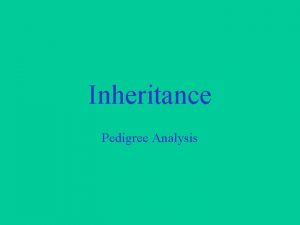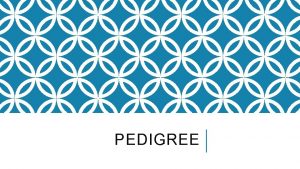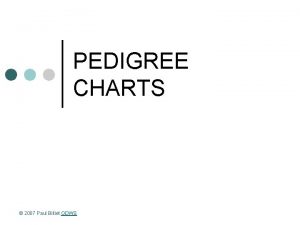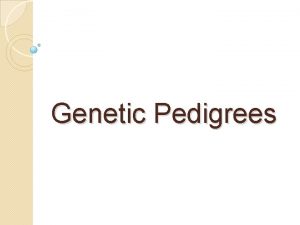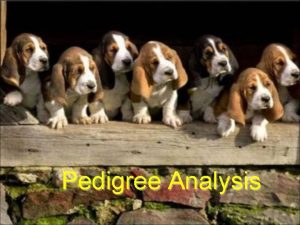Genetic Pedigree Diagrams What are genetic pedigree diagrams







- Slides: 7

Genetic Pedigree Diagrams

What are genetic pedigree diagrams? • Show an inherited trait (characteristic) runs in a group of related individuals. You might have to interpret genetic diagrams to work out the genotypes or potential phenotypes of individuals.

Cystic Fibrosis • Inherited disorder that causes the production of a thick mucus, which affects the lungs and digestive system. • It is caused by a faulty recessive allele (f). • A person with CF is homozygous from the allele (ff). • (Ff) is a carrier of CF.

Two parents are joined by a horizontal line Key shows what the shapes represent 2 1 Unaffected male Unaffected Female Children have a vertical line above them Vertical line goes from parents to children 3 4 5 Male with CF Female with CF 6 This female is CF (ff), but neither of her parents do. She must have inherited an f allele from each parent, so both parents must be carriers (Ff). This male has CF (ff), like his mother (ff). He's inherited an f allele from each parent, so his father must be a carrier (Ff).

Possible Question • Work out the chances of the next child born to individuals 4 and 5 having CF.

Question Affected female Unaffected Male • Huntington's disease is caused by a dominant allele. The genetic pedigree diagram shows the inheritance of Huntington's disease in one family. 5 1 2 3 4 1. What is the genotype of individual 1? 2. What would the possible genotypes of the offspring produced by a cross between individuals 3 and 5?

Answers 1. Heterozygous, e. g. Hh The cross between individual 1 and 2 has produced one affected child. As the unaffected child must have two recessive alleles, one from each parent, individual 1 must have one recessive allele and one dominant allele (Hh) to have the disorder and pass on an unaffected allele. 2. Heterozygous (Hh) and Homozygous recessive (hh). Individual 5 is unaffected so must be homozygous recessive (hh). Individual 3 has the disorder so must have at least one dominant allele, but they must also have one recessive allele from their unaffected parent (individual 2), so must be heterozygous (Hh)








